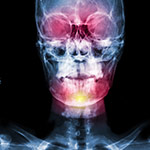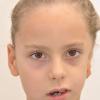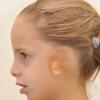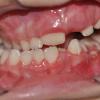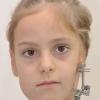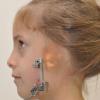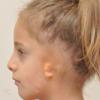MORPHOLOGICAL CHARACTERISTICS
Craniofacial (Hemifacial) Microsomia is a relatively common disorder in which the lower half of one side of the face is underdeveloped and does not grow normally having as a result facial asymmetry or/and malformative development of certain organs. The degree of malformation varies from mild degree that is just perceived up to very severe degree. The organs that are commonly affected are the lower jaw (mandibular hypoplasia) and auricles. The upper jaw (maxillary hypoplasia) and the cheekbone are also affected but to a lesser extent. In milder forms, the problem may only be the underdeveloped auricles or be observed a small degree facial asymmetry.
In the most severe forms, the lower jaw may be very malformative or not developed at all at the side of the face with this disorder. The soft tissues are not developed properly giving to the face a very asymmetrical appearance.
DIAGNOSIS
In milder forms, the problem may not be immediately apparent. In the most severe cases, diagnosis is done promptly, solely by physical examination.
Parents should be aware of the following:
- The craniofacial (hemifacial) microsomia is not associated with mental retardation, except in rare cases in which there may coexist disorders of the central nervous system.
- The newborn usually has no feeding difficulty, and there is no problem with breastfeeding.
- Once the unaffected side of the face is tested and found to be normal, there should be no attempt for surgical repair of the hearing mechanism on the affected side. This will render the subsequent reconstruction of the auricle extremely complex or impossible.
- Initially, there mustn't be performed any imaging examination such as CT and MRI unless there are serious suspicions for problems of the central nervous system.
- A team of doctors who are specialized in craniofacial surgery should undertake, from the beginning, the follow-up of the child because the participation of many specialties is required for his/her care.
SURGICAL REHABILITATION
In the early stages of a child's life, no intervention should be performed. The child must be followed-up by a team of doctors who are specialized in rehabilitation of craniofacial problems, to control his/her hearing and to ensure an excellent oral hygiene. If there are skin morphomas in front of the auricle or if the mouth slit is longer on the side of the problem, all these may be corrected during infancy.
At the age of 6, the child starts to make his/her first imaging examinations, such as 3D low dose CT, panoramic radiography in jaws. Depending on the findings, the plan of the surgical rehabilitation will be made.
- When all the molecules of the lower jaw have been doubled and asymmetry is in relatively small degree, then after the initial orthodontic preparation, it is performed a minor operation in which an incision is done into the jawbone and is placed a small machine which lengthens the jawbone 1mm per day in the appropriate direction, thereby improving the symmetry (distraction osteogenesis, see method).
- In serious cases in which a part of the lower jaw hasn't been doubled, major surgeries will be required, which are performed in an older age as well.
- After the rehabilitation of skeletal molecules, it is performed the rehabilitation of the soft tissues with various dermis-fat grafts (DFG0, fat injections etc.
- The auricle is restored last in order to ensure its accurate placement in the correct position.
It is therefore obvious that the surgical rehabilitation of craniofacial (hemifacial) microsomia is a long-term undertaking that requires close cooperation between the parents and the craniofacial team. It is the only way to ensure the best possible result with the least possible discomfort of the child and his/her family.

